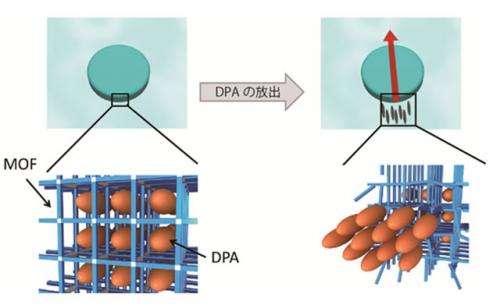October 30, 2012 weblog
MOF speedboat study adds spark to smart autonomous motors

(Phys.org)—Research towards self-propelling microscopic machines has a boost in the form of a newly published study by researchers at City University of New York-Hunter College and Kyoto University in Japan. They worked out a 'molecular motor' that can move, speedboat-style, across a liquid surface.
"Autonomous motors of a metal–organic framework powered by reorganization of self-assembled peptides at interfaces" has been published in the journal Nature Materials. The journal presents new research in materials science and engineering. The study authors noted that a variety of microsystems have been developed that harness energy and convert it to mechanical motion, but they have developed "new autonomous biochemical motors by integrating a metal–organic framework (MOF) and self-assembling peptides."
.
The team designed a type of molecular motor that is capable of propelling itself across a liquid surface. They used a highly porous MOF device constructed to leak organic peptide molecules out of the slit, which propels the boat. "The MOF is applied as an energy-storing cell that assembles peptides inside nanoscale pores of the coordination framework," they wrote. The researchers, led by Hiroshi Matsui of Hunter College, filled the pores in an MOF with the peptide diphenylalanine and floated the particles on water. Adding ethylenediaminetetraacetate (EDTA) partially degraded the MOF which allowed the peptide to escape from the pores. "The neat MOF particle is descended immediately to the bottom of the EDTA solution with no transitional and rotational motions and it does not decompose visibly under the microscope in the time frame of this experimental setting," they wrote.
Explaining their work further, Chemistry World, the Royal Society of Chemistry publication, said. "Upon reaching the water, the peptide spontaneously reassembles into a hydrophobic aggregate, reducing the surface tension at that point. The creation of a surface-tension gradient forces the particles to move towards the area with higher surface tension, a phenomenon known as the Marangoni effect."
Scientific efforts to imitate nature's motile life forms have been part of the quest for autonomous microscopic machines. The study authors said that "This demonstration opens the route towards new applications of MOFs and reconfigurable molecular self-assembly, possibly evolving into a smart autonomous motor capable of mimicking swimming bacteria and, with integrated recognition units, harvesting target chemicals." The authors are Yasuhiro Ikezoe, Gosuke Washino, Takashi Uemura, Susumu Kitagawa and Hiroshi Matsui.
More information:
www.nature.com/nmat/journal/va … t/full/nmat3461.html
Nature Materials, 2012, DOI: 10.1038/nmat3461
Journal information: Nature Materials
© 2012 Phys.org



















